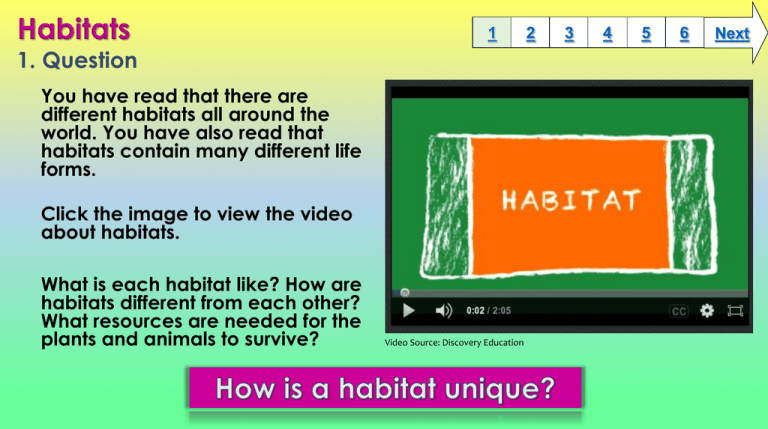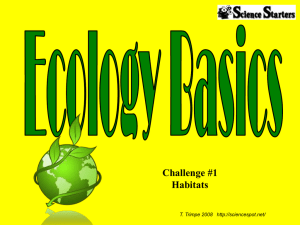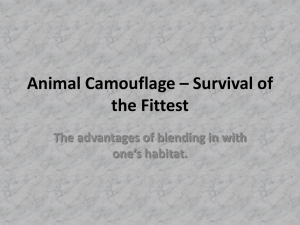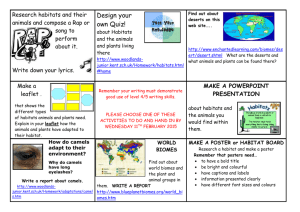
1
1. Question
You have read that there are
different habitats all around the
world. You have also read that
habitats contain many different life
forms.
Click the image to view the video
about habitats.
What is each habitat like? How are
habitats different from each other?
What resources are needed for the
plants and animals to survive?
Video Source: Discovery Education
2
3
4
5
6
Next
2. Information Sources
1
2
3
4
5
6
Next
Use the resources below to help you identify the unique characteristics of a habitat.
Animal
Habitats
Pond and
Lake Habitats
Habitat
Videos
Videos on Habitats
Navigate and log into
Discovery Ed and search
for Habitats
Animals
What is a
habitat?
Tide Pools
Different Types
of Habitats
Check out these books
on TumbleBooks!
.
* If you are asked to login, contact your Library Media Specialist for login information.
Image Sources: TumbleBooks by subscription.
3. Student Activity
1
2
3
4
Using the resources on
slide 2 and what you
already know about
habitats, complete the
organizer .
Be sure to write down
information that relates to
your habitat – you will
need this information to
complete the final project!
Image Source from: Clipart.com by subscription.
5
6
Next
4. Assessment Activity
1
2
3
4
5
6
Share your new knowledge about
habitats!
You can choose one of these tools to display
what you have learned:
• A brochure
• A PowerPoint
• A book cover jacket
• Printing Press
• Discovery Education Board Builder
Log in to Discovery Education and navigate to the
Builder Tools drop down menu – you will find Board
Builder there!
Use this rubric to help you complete your project.
Image Source from: Clipart.com by subscription.
Next
5. Enrichment Activities
1
2
3
4
5
6
Once you have completed your project, you can
explore these activities.
After you have completed you work
spend some time testing your
knowledge about habitats:
• Build a Habitat
• Navigate to Discovery Ed, log in and
search for the following quiz:
• The Whaddaya Know? Quiz Show: Animal
Habitats
Reading Rainbow: The Secret Shortcut
Segment- Mapping a Primate Habitat
Video Source: Discovery Education
• Habitat Song: Click the speaker to listen
to the habitat song and guess the
habitat what is being described.
If you are asked to login, see your Library Media
Specialist for login information.
Next
6. Teacher Support Materials
Grade 2 ELA/Library Media
1
Common Core State Standards
Reading: 1. Read closely to determine what the text says explicitly and to make logical inferences from it; cite specific
textual evidence when writing or speaking to support conclusions drawn from the text.
Reading: RI 2.3 Describe the connection between a series of historical events, scientific ideas or concepts, or steps in a
technical procedures in a text.
Writing: 7. Conduct short as well as more sustained research projects based on focused questions, demonstrating
understanding of the subject under investigation.
3
4
5
6
Time Frame: Two 50 minute lessons using student devices or the
BCPS Curriculum / Maryland State Curriculum
Grade 2 ELA Curriculum and Library Curriculum
Unit 4: Unique
2
computer lab.
Differentiation strategies for this lesson:
•
Direct students to use comprehension tools included in databases,
such as: audio read-aloud, labeled reading levels, and embedded
dictionaries.
•
On page 2, the silver stars are basic or on grade level resources and the
gold stars are advanced or above grade level resources.
Learning Styles addressed in this lesson:
Auditory, Visual, Kinesthetic, Reflective, Sequential, Field Independent
Writing: 2.2 Write informative/explanatory texts in which students introduce a topic, use facts and definitions to
develop points, and provide a concluding statement or section.
Standards for the 21st Century Learner
1.1.6 Read, view, and listen for information presented in any format (e.g. textual, visual, media, digital) in order to
make inferences and gather meaning.
2.1.3 Use strategies to draw conclusions from information and apply knowledge to curricular areas, real-world
situations, and further investigations.
Notes to the teacher:
• Collaborate with your school library media specialist to complete this
lesson.
• Make sure to have database passwords available in case students have
trouble with the links.
ISTE - National Educational Technology Standards for Students
• If you would prefer make copies of the organizer and brochure for
students complete rather than completing on the computer.
3. Research and Information Fluency: Students apply digital tools to gather, evaluate, and use information.
b. Locate, organize, analyze, evaluate, synthesize, and ethically use information from a variety of sources and media.
• Students will need headphones to listen to the sound provided by songs,
movie clips, and games.
4. Critical Thinking, Problem Solving, and Decision Making: Students use critical thinking skills to plan and conduct
research, manage projects, solve problems, and make informed decisions using appropriate digital tools and
resources. c. Collect and analyze data to identify solutions and/or make informed decisions.
• All students are allowed to complete the enrichment page after
completing their work.
Last updated: July 2015 Created by Marlena Aumen, Library Media Specialist Intern
BCPS Slam Dunk Research Model, Copyright 2013, Baltimore County Public Schools, MD, all rights reserved. The models may be used for educational, non-profit school use only.
All other uses, transmissions, and duplications are prohibited unless permission is granted expressly. This lesson is based on Jamie McKenzie’s Slam Dunk Lesson module.









